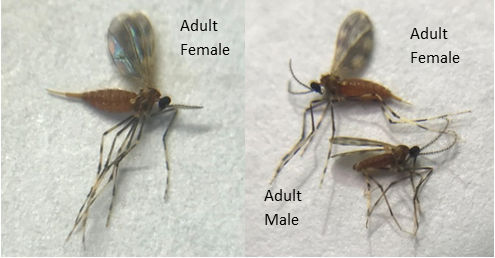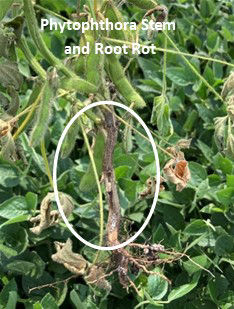3 MIN READ
A Guide to Scouting and Identifying Soybean Gall Midge
March 12, 2023
Soybean Gall Midge History
Soybean gall midge (Resselielia maxima) (SGM) is a relatively new Midwestern soybean insect pest with initial discovery in Nebraska in 2011. The larval stage is the crop damaging stage. The insect is currently specific to Eastern Nebraska, Western Iowa, Southeast South Dakota, Southwest Minnesota, and Northwestern Missouri.
Identification1
Adult (Figure 1)
- Adults are tiny, slender bodied flies about 1/4 inch long with long legs, an orange abdomen, and mottled wings.
- Antennae and legs have alternating light and dark bands.
- Because of their small size, the adults are unlikely to be observed in the field.
- Females are larger than the males, redder in color, with a visible ovipositor.

Larva (Figure 2)
- Small legless maggot.
- Passes through three instars before pupating:
- First Instar – very small (1/16th inch long) and clear maggot.
- Second Instar – maggot becomes milky-white or light orange and 1/16th to 1/8th inch long.
- Third Instar – maggot is bright orange to red/orange and 1/16th to 1/8th inch long.
- All three instars can be present under one soybean epidermis, indicating infestation at differing times by differing females.

Life Cycle
- Overwintering adults emerge from previous year soybean stubble around the middle of June.
- Emergence may occur over a four-week timeframe.
- The adults (flies) emerge from their overwintering pupal stage and fly to soybean plants on the field edges of current season soybean fields.
- The females find cracks/fissures on the lower portion soybean stems that have reached at least the V2 to V3 growth stage, pierces the stem with their ovipositors, and inserts eggs into the stem (Figure 3).1,2
- When the larvae emerge from the eggs under the stem epidermis, they begin feeding on vascular stem tissue between the soil line and cotyledons (Figure 4).
- Overall, the life cycle (egg, larva, pupa, adult) takes around four weeks to complete.
- Multiple overlapping generations occur throughout one growing season.
- As the growing season and SGM generations progress, signs, and symptoms of SGM infestation progress inward toward the middle of the soybean field.
- The larvae pass through three instars (Figure 2), and after completing the third instar the larvae fling themselves from the soybean stem, onto the soil surface and burrow down into the soil to pupate and begin the life cycle over again.
- The final larval generation overwinters in the soil in the soybean stubble.
- Larvae from the current soybean crop (possibly other bean crops, sweet clover, and alfalfa) overwinter within the first few inches of soil (Figure 3).1,2


Symptoms and Damage
- Usually, plants along field borders and waterways develop symptoms first.
- The lower stem exterior can look greasy with a dark purple to brown hue where the larvae are feeding beneath the epidermis (Figure 5).
- Discoloration can mimic symptoms caused by the pathogens Phytophthora and Rhizoctonia (Figure 6).
- The epidermis can deteriorate and expose the inner pith (Figure 7).
- Galls may form in the damaged area (Figure 8).
- Plants may wilt, snap, show brittleness at the soil level, or prematurely die (Figure 9).
- Death can occur directly from the feeding and indirectly through loss of nutrients and water because of damaged interior pith.





Scouting
- If a field was infested the previous year, adjacent fields planted to soybean should be scouted beginning at the V2 to V3 growth stage.
- Observe the border rows for the symptoms described above.
- If symptoms are present, peel back soybean stem epidermis to look for clear to orange larvae (Figures 10 and 11).


Management
- No established management strategies are currently available to suppress adult infestation or larval feeding.
- Since larvae feed within the stem, insecticide applications after discovery are ineffective.
Sources:
1Dean, A. and Hodgson, E. Soybean gall midge. Integrated Crop Management. Iowa State University Extension and Outreach. https://crops.extension.iastate.edu/encyclopedia/soybean-gall-midge/.
2Tilmon, K. (The Ohio State University) and Jardine, D.J. (Kansas State University). Soybean gall midge. Soybean Research & Information Network. United Soybean Board and North Central Soybean Research Program. https://soybeanresearchinfo.com/soybean-pest/soybean-gall-midge/.
Web sites verified 1/18/23
1315_136265